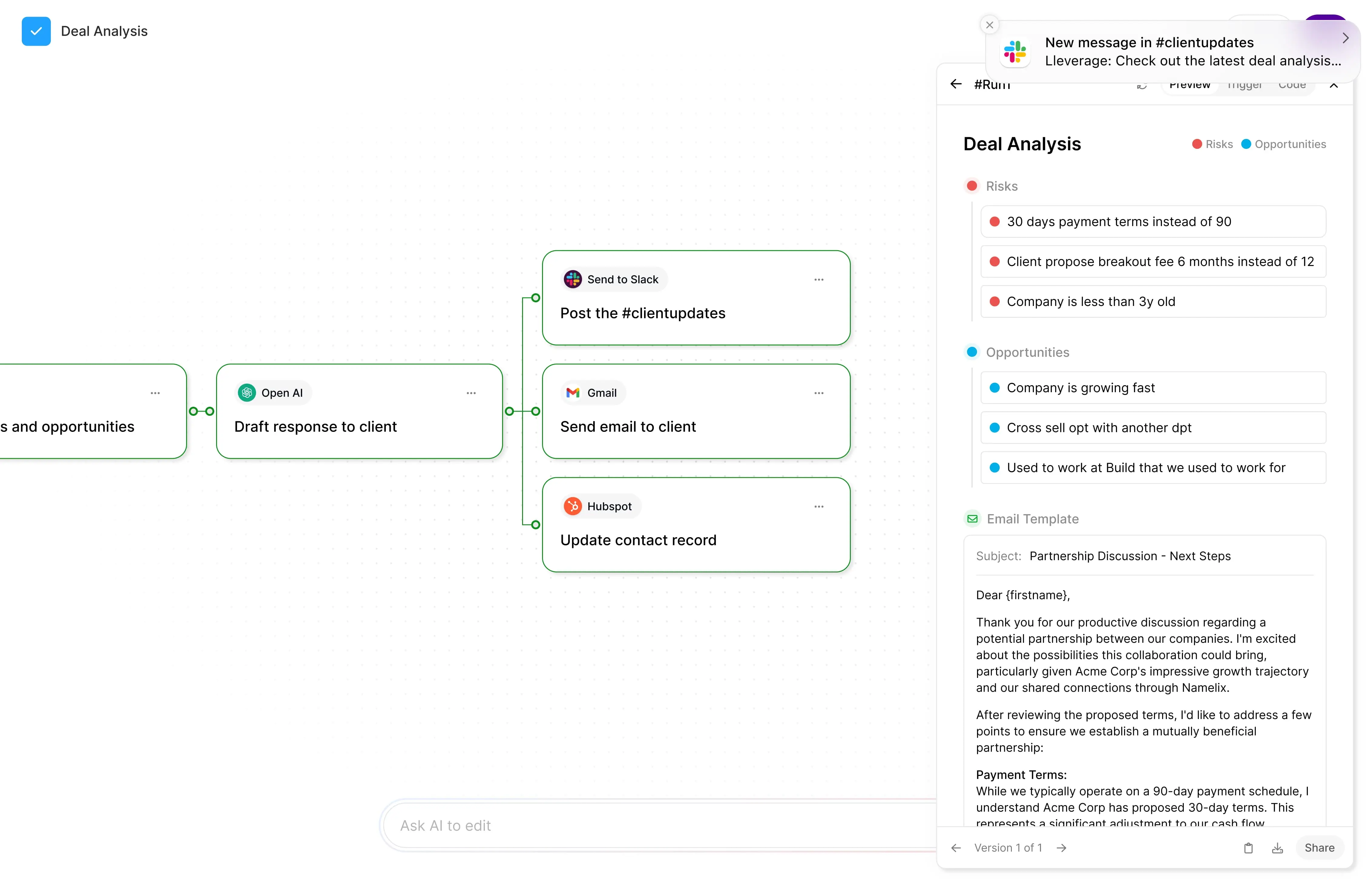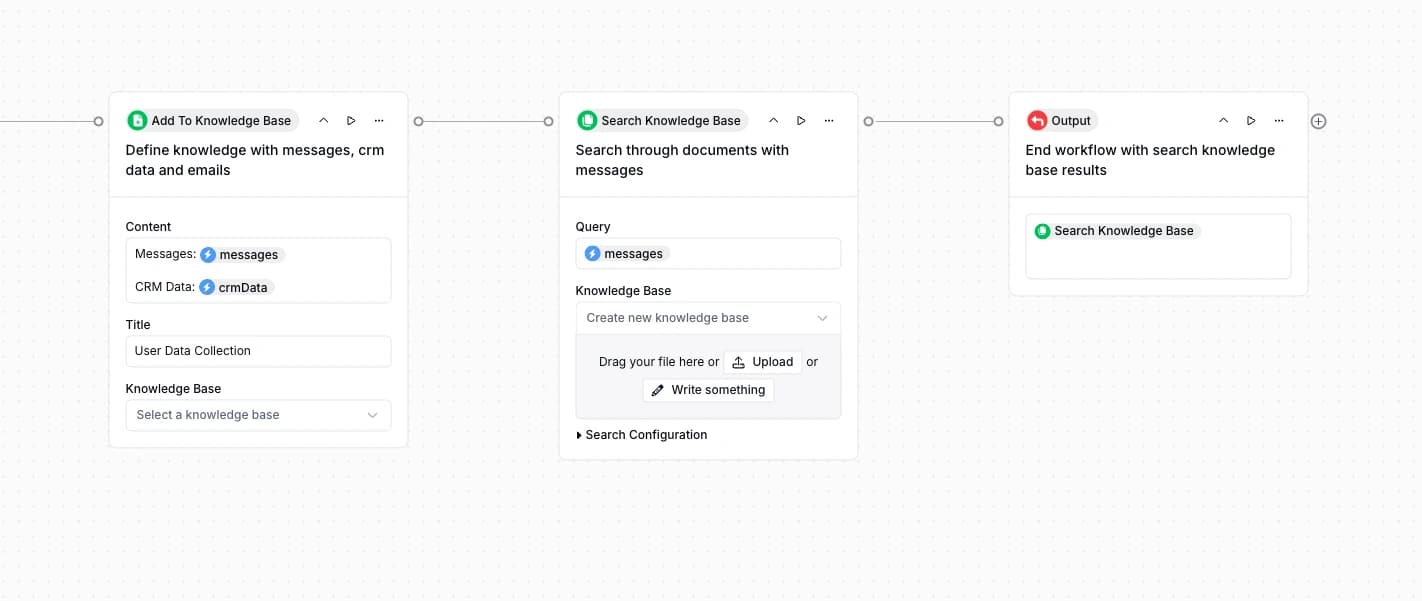What is the difference between AI agents and AI workflows?
Explore the key differences between AI workflows and AI agents, their applications, and how to choose the right automation solution for your needs.

AI is giving businesses an incredible opportunity to automate a lot of their operations, but not all automation works the same way. If you've come across terms like “AI workflows” and “AI agents” and wondered what sets them apart, or which one is right for your business, you’re not alone.
In this article, we’ll break down the key differences, explore real-world use cases, and help you decide how to best use AI to automate your operations.
AI workflows vs AI agents: What’s the difference?
AI workflows and AI agents are two distinct approaches to automation, each serving different purposes:
- AI workflows: These are structured processes designed to handle repetitive, rule-based tasks like document processing or ticket management. They focus on consistency and precision, integrating with various tools and stages for a controlled sequence.
- AI agents: These are autonomous systems that can learn, adapt, and make decisions in real time. They are ideal for dynamic environments requiring flexible, context-driven responses, such as customer service or real-time inventory management.
If you’re trying to figure out which one makes the most sense for your business, here’s a quick side-by-side comparison to help. This table gives you a high-level view of how AI workflows and AI agents stack up. But if you want a deeper dive into how they work and when to use them, keep reading!
👉 Key takeaway: Use AI workflows for predictable, repetitive tasks and AI agents for complex, decision-driven scenarios. Platforms like ours at Lleverage allow businesses to combine both for maximum efficiency.
AI workflows explained: Everything you need to know
AI workflows turn complex tasks into structured, repeatable processes, making operations more efficient and reducing human error. Think of them as step-by-step automation pipelines that ensure everything runs smoothly, whether that’s processing invoices, routing customer support tickets, or handling compliance checks.
Core functions of AI workflows
AI workflows rely on a mix of NLP, RPA, and the software tools you use. Together, these technologies create a framework capable of managing intricate business processes with accuracy.
Here's how they work:
These functions form the backbone of AI workflows that enable companies to achieve better efficiency and performance.
AI workflow examples
AI workflows shine in tasks like document processing, where they can automatically extract, classify, and route information. This capability is especially valuable in industries like healthcare and finance.
"AI workflows support AI automation by enabling non-technical employees to build and automate workflows independently using no-code platforms. This reduces reliance on IT teams, accelerates innovation, and boosts productivity." – Joost Verdoorn, CPO at Lleverage
Tools like our very own visual workflow builder can even make it easy for non-technical users to design and deploy automated processes.
Some key applications of AI workflows include:
These workflows are ideal for businesses looking to automate operations while maintaining precision and efficiency. They work best in structured environments where repetitive, rule-based processes are critical to keeping things running smoothly.
For instance, an insurance company processing thousands of claims each month can use AI workflows to sort, validate, and approve straightforward cases automatically. This then allows human agents to focus on more complex claims that require judgment and expertise.
AI agents explained
Once businesses automate repetitive tasks with AI workflows, they can take it to the next level with AI agents – programs designed to operate and make decisions on their own with little human input.
AI agents are self-governing programs capable of making decisions and functioning in real time. Unlike traditional automation tools, these agents use advanced technology to act independently.
How AI agents work
AI agents bring together technologies like NLP and autonomous decision-making systems. Their functionality is built on three main capabilities:
These agents use reasoning to analyze data and make decisions based on both past patterns and the current situation. This enables them to handle complex scenarios that traditional systems can't manage effectively. They can be useful in many different industries, as we’ll see below.
AI agent examples
Here are some more industries where AI agents are making an impact:
AI agents thrive in environments where conditions shift frequently, and swift, intelligent decisions are essential. Their ability to learn from every interaction and improve over time makes them a powerful tool for businesses aiming to become more efficient while maintaining accuracy and personalization.
AI agents vs AI workflows: Key differences
Understanding the difference between AI agents and AI workflows is crucial for choosing the right automation tool.
Below, we’ll compare how the two stack up against each other based on six different factors:
- Automation type
- Learning capability
- Decision-making framework
- Adaptability
- Task complexity
- Implementation scope
We’ll take an in-depth look at each one, but here’s a quick overview:
Automation type
AI workflows follow a predefined sequence of steps, automating repetitive processes that require consistency and rule-based execution. They work like assembly lines – efficient for structured tasks but rigid in handling variations.
AI agents, on the other hand, enable more dynamic automation by making context-aware decisions. They continuously evaluate inputs and adjust actions in real-time, making them suitable for tasks that involve unpredictable scenarios, such as optimizing logistics routes based on live traffic data.
Learning capability
AI workflows do not learn from past executions; they rely on explicitly programmed logic and require manual adjustments to improve performance. In contrast, AI agents leverage AI to refine their actions over time. By analyzing historical data and user interactions, they can identify patterns, anticipate needs, and improve decision-making.
For example, while a workflow-based system in procurement may always flag purchases exceeding a set budget, an AI agent could learn spending patterns and suggest cost-saving alternatives based on supplier trends.
Decision-making capabilities
AI workflows operate based on fixed rules, executing tasks in a straightforward, step-by-step manner. On the other hand, AI agents can make independent decisions by analyzing the relevant context and adapting to new information.
For instance, in customer service, an AI workflow might simply assign tickets to teams based on predefined categories. In contrast, an AI agent can assess customer sentiment, prioritize issues, and tailor responses based on past interactions.
Adaptability
Since AI workflows are designed around rigid logic, they struggle to adapt to changing conditions without manual intervention. Any deviation from the expected inputs or processes often leads to errors or inefficiencies. AI agents, however, are built for adaptability. They process new data in real time and adjust their behavior accordingly.
In a supply chain setting, an AI workflow may follow a fixed replenishment schedule, while an AI agent could dynamically adjust orders based on real-time demand fluctuations and supplier constraints.
Task complexity
AI workflows excel at handling well-defined, linear processes that involve structured inputs and predictable outputs. They are ideal for tasks like invoice processing, where the steps remain the same every time.AI agents, however, can manage tasks with higher complexity, where multiple variables influence the outcome.
In fraud detection, for example, an AI workflow might flag transactions above a certain threshold, whereas an AI agent could analyze transaction history, user behavior, and contextual signals to determine the likelihood of fraudulent activity.
Implementation scope
AI workflows are designed with a narrow, task-specific focus, making them ideal for automating processes within a particular department or function. They require less customization and are typically easier to implement, but their impact is big within specific, predefined tasks.
In contrast, AI agents offer broader operational flexibility, capable of integrating with multiple systems and adapting across various functions. They can manage complex, cross-functional processes, enabling organizations to optimize operations at a larger scale, from resource allocation to customer interaction management.
Choosing between AI agents and AI workflows
Picking between AI agents and workflows boils down to understanding your automation needs. While AI workflows handle predefined tasks with precision, AI agents step in for autonomous, decision-making roles. Let’s break down when each fits best.
Platforms like Lleverage make it simple to combine both tools. With drag-and-drop interfaces and built-in AI, businesses can create powerful automation solutions – no coding skills required.
"The future of AI isn’t just about automating tasks but working alongside humans, boosting creativity and decision-making while tackling complex challenges." – Lennard Kooy, CEO at Lleverage
As companies refine their digital strategies, tapping into the strengths of both AI workflows and agents will become essential. Success lies in applying each tool where it makes the most impact.
How to integrate AI agents and workflows with AI automation tools
No-code platforms are making it easier than ever to integrate AI workflows and agents, enabling users without technical expertise to set up advanced automation.

Platforms like Lleverage (yeah, that’s us 👋) make it simple to combine AI workflows and agents. With our visual workflow and agent builder, teams can design intricate processes without writing a single line of code.
Here’s a snapshot of our platform’s key features:
No-code platforms make it possible for any business to get started with AI automation. They can benefit your business in a number of ways:
✅ Accessible development: Non-technical users can create and refine workflows independently, reducing reliance on IT teams and speeding up innovation.
✅ Improved efficiency: These platforms combine workflows and agents to automate complex, multi-step tasks. Features like document processing, insights prediction, and personalization help operations run more smoothly and effectively.
✅ Scalable growth: With enterprise-grade options like single sign-on, custom deployments, and unlimited vector storage, no-code platforms can grow alongside your business without creating extra technical challenges.
Ready to see how easy it is to integrate AI agents and workflows into your operations? Book a demo and discover how Lleverage can automate your business processes with our zero-code AI automation platform.



.jpg)

